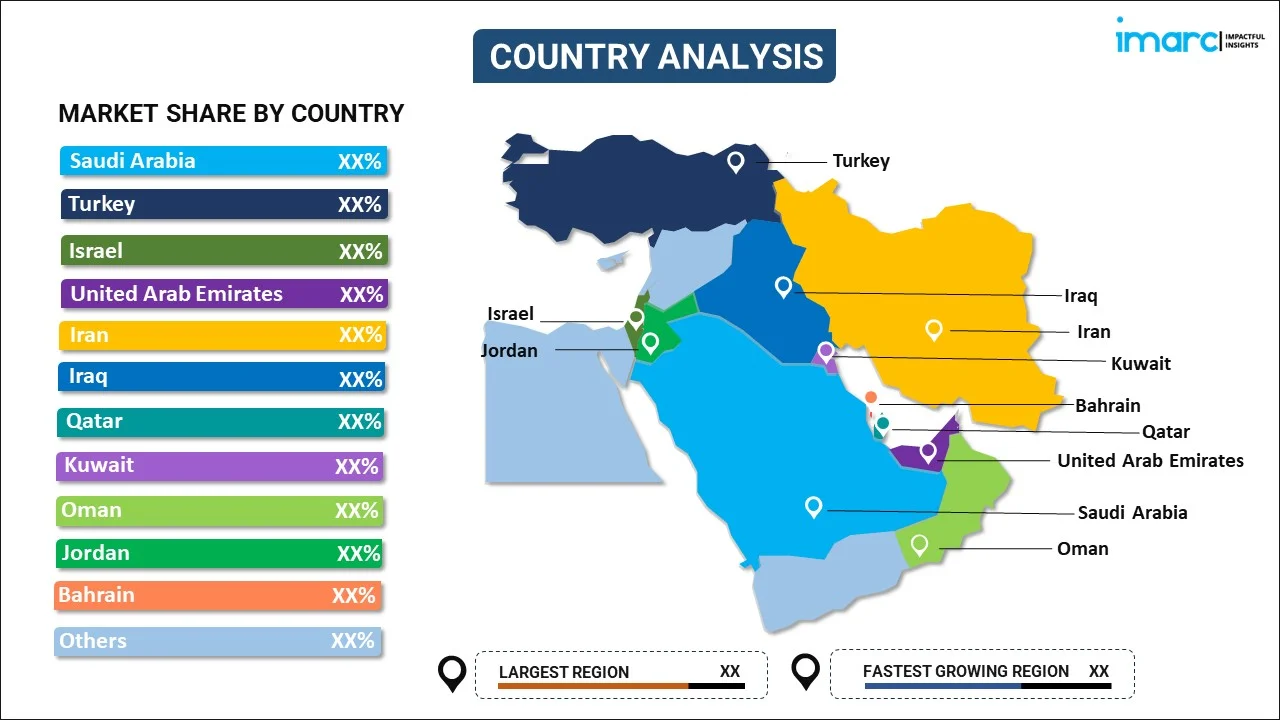
Middle East Steel Market Report by Type (Flat Steel, Long Steel), Product (Structural Steel, Prestressing Steel, Bright Steel, Welding Wire and Rod, Iron Steel Wire, Ropes, Braids), Application (Building and Construction, Electrical Appliances, Metal Products, Automotive, Transportation, Mechanical Equipment, Domestic Appliances), and Country 2024-2032
Market Overview:
Middle East steel market size is projected to exhibit a growth rate (CAGR) of 4.60% during 2024-2032. The market is being propelled by substantial expansion in construction and infrastructure development, an increasing embrace of advanced manufacturing technologies and processes, and growing apprehensions regarding environmental sustainability and carbon emissions.
|
Report Attribute
|
Key Statistics
|
|---|---|
|
Base Year
|
2023 |
|
Forecast Years
|
2024-2032
|
|
Historical Years
|
2018-2023
|
| Market Growth Rate (2024-2032) | 4.60% |
Steel is a widely utilized alloy consisting primarily of iron and carbon, supplemented by small amounts of other elements. It is renowned for its strength, versatility, and durability, establishing it as a crucial material across diverse industries and everyday applications. Its malleability allows it to be molded into various structures such as beams, sheets, rods, and wires, catering to a wide array of purposes. The applications of steel span construction, manufacturing, transportation, and infrastructure projects, serving as a foundational material in the creation of buildings, bridges, automobiles, ships, machinery, and appliances. Notably, its outstanding strength-to-weight ratio renders it ideal for constructing robust and dependable structures. Steel's ductility ensures flexibility without compromising integrity, providing resistance against fractures and deformation. Furthermore, its recyclability contributes to sustainability and environmental advantages.
Middle East Steel Market Trends:
The Middle East's steel market stands at the nexus of dynamic economic growth, robust infrastructure development, and a burgeoning demand for construction materials. With an impressive surge in construction and infrastructure projects across the region, steel has emerged as a pivotal material, owing to its inherent strength, adaptability, and durability. Additionally, the towering skyscrapers, expansive bridges, and modern urban landscapes of the Middle East are testament to the extensive use of steel in shaping the region's architectural footprint. Moreover, the rising adoption of advanced manufacturing technologies and processes has further fueled the demand for high-quality steel products, meeting the stringent requirements of modern construction. Environmental sustainability and the mitigation of carbon emissions have become central concerns, and the Middle East is no exception. As the region prioritizes sustainable development, steel's recyclability and potential for reduced environmental impact contribute to its significance in the market. Apart from this, with a confluence of factors driving its growth, including urbanization, industrialization, and a commitment to sustainability, the Middle East steel market will continue to play a pivotal role in shaping the region's economic and infrastructural landscape over the forecasted period.
Middle East Steel Market Segmentation:
IMARC Group provides an analysis of the key trends in each segment of the market, along with forecasts at the regional and country levels for 2024-2032. Our report has categorized the market based on type, product, and application.
Type Insights:

- Flat Steel
- Long Steel
The report has provided a detailed breakup and analysis of the market based on the type. This includes flat steel and long steel.
Product Insights:
- Structural Steel
- Prestressing Steel
- Bright Steel
- Welding Wire and Rod
- Iron Steel Wire
- Ropes
- Braids
A detailed breakup and analysis of the market based on the product have also been provided in the report. This includes structural steel, prestressing steel, bright steel, welding wire and rod, iron steel wire, ropes, and braids.
Application Insights:
- Building and Construction
- Electrical Appliances
- Metal Products
- Automotive
- Transportation
- Mechanical Equipment
- Domestic Appliances
The report has provided a detailed breakup and analysis of the market based on the application. This includes building and construction, electrical appliances, metal products, automotive, transportation, mechanical equipment, and domestic appliances.
Country Insights:

- Saudi Arabia
- Turkey
- Israel
- United Arab Emirates
- Iran
- Iraq
- Qatar
- Kuwait
- Oman
- Jordan
- Bahrain
- Others
The report has also provided a comprehensive analysis of all the major regional markets, which include Saudi Arabia, Turkey, Israel, United Arab Emirates, Iran, Iraq, Qatar, Kuwait, Oman, Jordan, Bahrain, and Others.
Competitive Landscape:
The market research report has also provided a comprehensive analysis of the competitive landscape. Competitive analysis such as market structure, key player positioning, top winning strategies, competitive dashboard, and company evaluation quadrant has been covered in the report. Also, detailed profiles of all major companies have been provided.
Middle East Steel Market Report Coverage:
| Report Features | Details |
|---|---|
| Base Year of the Analysis | 2023 |
| Historical Period | 2018-2023 |
| Forecast Period | 2024-2032 |
| Units | US$ Million |
| Scope of the Report | Exploration of Historical and Forecast Trends, Industry Catalysts and Challenges, Segment-Wise Historical and Predictive Market Assessment:
|
| Types Covered | Flat Steel, Long Steel |
| Products Covered | Structural Steel, Prestressing Steel, Bright Steel, Welding Wire and Rod, Iron Steel Wire, Ropes, Braids |
| Applications Covered | Building and Construction, Electrical Appliances, Metal Products, Automotive, Transportation, Mechanical Equipment, Domestic Appliances |
| Countries Covered | Saudi Arabia, Turkey, Israel, United Arab Emirates, Iran, Iraq, Qatar, Kuwait, Oman, Jordan, Bahrain, Others |
| Customization Scope | 10% Free Customization |
| Report Price and Purchase Option | Single User License: US$ 3699 Five User License: US$ 4699 Corporate License: US$ 5699 |
| Post-Sale Analyst Support | 10-12 Weeks |
| Delivery Format | PDF and Excel through Email (We can also provide the editable version of the report in PPT/Word format on special request) |
Key Questions Answered in This Report:
- How has the Middle East steel market performed so far and how will it perform in the coming years?
- What has been the impact of COVID-19 on the Middle East steel market?
- What is the breakup of the Middle East steel market on the basis of type?
- What is the breakup of the Middle East steel market on the basis of product?
- What is the breakup of the Middle East steel market on the basis of application?
- What are the various stages in the value chain of the Middle East steel market?
- What are the key driving factors and challenges in the Middle East steel?
- What is the structure of the Middle East steel market and who are the key players?
- What is the degree of competition in the Middle East steel market?
Key Benefits for Stakeholders:
- IMARC’s industry report offers a comprehensive quantitative analysis of various market segments, historical and current market trends, market forecasts, and dynamics of the Middle East steel market from 2018-2032.
- The research report provides the latest information on the market drivers, challenges, and opportunities in the Middle East steel market.
- Porter's five forces analysis assist stakeholders in assessing the impact of new entrants, competitive rivalry, supplier power, buyer power, and the threat of substitution. It helps stakeholders to analyze the level of competition within the Middle East steel industry and its attractiveness.
- Competitive landscape allows stakeholders to understand their competitive environment and provides an insight into the current positions of key players in the market.
Need more help?
- Speak to our experienced analysts for insights on the current market scenarios.
- Include additional segments and countries to customize the report as per your requirement.
- Gain an unparalleled competitive advantage in your domain by understanding how to utilize the report and positively impacting your operations and revenue.
- For further assistance, please connect with our analysts.
 Inquire Before Buying
Inquire Before Buying
 Speak to an Analyst
Speak to an Analyst
 Request Brochure
Request Brochure
 Request Customization
Request Customization




.webp)




.webp)












